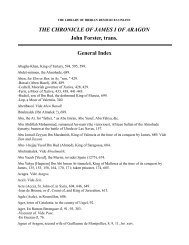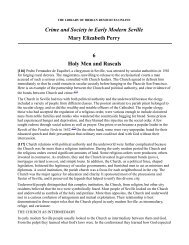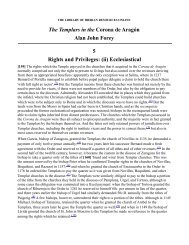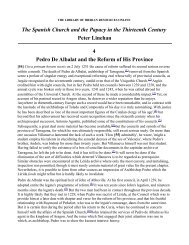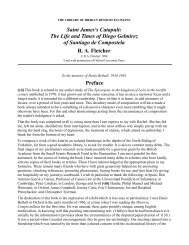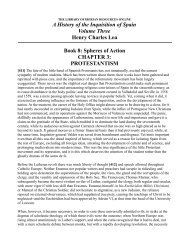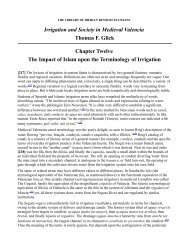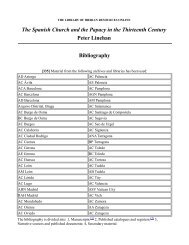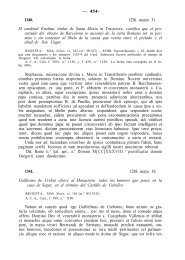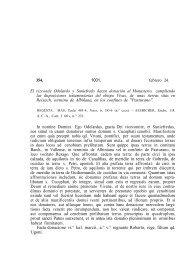Chapter 11 - The Library of Iberian Resources Online
Chapter 11 - The Library of Iberian Resources Online
Chapter 11 - The Library of Iberian Resources Online
Create successful ePaper yourself
Turn your PDF publications into a flip-book with our unique Google optimized e-Paper software.
1850 (Madrid: Martín y Salazar, 1855), 1:109ff. and the apéndice musical. He claimed to have taken<br />
them from the so-called Cancionero de Marialva , which belonged to D. Francisco Contino, Conde de<br />
Marialva , and which to date has not been located. See Anglés/Subiá , Catálogo musical, 1: 281-83,<br />
and Anglés, La música, 2: 16-17, n. 2.<br />
[34] . Hilarión Eslava, Cantiga 14 del rey don Alfonso el Sabio, parafraseada con coros y orquesta<br />
(Madrid: Fétis , [1861?]). Joseph Snow, <strong>The</strong> Poetry <strong>of</strong> Alfonso X, El Sabio: A Critical Bibliography<br />
(London: Grant and Cutler, 1977), no. 31, who did not see this composition, cites (Antonio) Palau (y<br />
Dulcet), Manual [del librero hispano-americano, 2nd edn . (Barcelona: A. Palau, 1948)], 1 : 206,<br />
where it is listed as item 7136. Snow (no. 71) also suggested that Felipe Pedrell's Seis cantigas,<br />
transcriptas y harmonizadas con acompañadp de órgano o harmonio. Textos orginales y versiones en<br />
castellano (Barcelona: Vidal Llimona y Boceta, 1905-101?) "probably appeared first, singly, in the<br />
review Salterio Sacro Hispano, ca . 1882 -83."<br />
[35] . See Villalba above in n. 16. Pedrell , Cancionero musical popular español (Madrid: J.<br />
Fernández Arias, 1914), 1: nos. 145-48; 3 ( Vails , Spain: Eduard Castells , 1920): nos. 1-4. For<br />
information concerning Breton's settings, see Julián Ribera Tarrago, "Valor de la música de las<br />
Cantigas," in Discursos leídos ante S. M. el Rey y la real familia (23 de noviembre de 1021 ) . . . para<br />
conmemorar el VII centenario del nacimiento del rey don Alfonso el Sabio (Madrid: Tipografía de la<br />
Revista de Archivos, Bibliotecas y Museos, 1921), 7-20. Breton's arrangements, based on Ribera's<br />
transcriptions, were interspersed among the various discourses presented during the evening. <strong>The</strong>se<br />
arrangements were not published.<br />
[36] . See Aubry and Ribera above in n. 14; see Sunyol above in n. 28, and Trend, Music <strong>of</strong> Spanish<br />
History, mus. exs . 9-14.<br />
[37] . Anglés , La música de las Cantigas de Santa Maria del rey Alfonso el Sabio, facsimile with<br />
transcriptions and study, 3 vols. (Barcelona: Diputación Provincial, 1943 - 1964). Volume two (1943)<br />
contains the musical transcriptions.<br />
[38] . However, it was Elias F. Dexter who undertook the first serious study <strong>of</strong> Alfonso's sources for<br />
his Cantigas, among which was Les Miracles de la Sainte Vierge <strong>of</strong> Gautier de Coincy (<strong>11</strong>77/<strong>11</strong>78-<br />
1236). See Dexter's "Sources <strong>of</strong> the 'Cantigas' <strong>of</strong> Alfonso el Sabio" (Ph.D. diss ., University <strong>of</strong><br />
Wisconsin, 1926). See also Walter Mettmann , "Os Miracles de Gautier de Coinci como fonte das<br />
Cantigas de Santa Maria," Homenagen Luciana Stegagno Picchio (in press). Peter Dronke observes<br />
that "only in the twelfth century [such] expressions ... as ' flos florum ', 'rosa rosarum ' became a<br />
common currency in hymns." See Dronke, Medieval Latin and the Rise <strong>of</strong> European Love-Lyric<br />
(Oxford: Clarendon Press, 1965), 186.<br />
[39] . Katz , " Anglés and Melodic Origins ," 53-54.<br />
[40] . Wilkes , "La XI cantiga de Alfonso el Sabio y su armonización por Julián Ribera," Revista del<br />
pr<strong>of</strong>esorado [Buenos Aires] ( June 1942): 109-24, esp. <strong>11</strong>8 and 120, respectively. Wilkes confused the<br />
numbering <strong>of</strong> "Rosa das rosas," referring to it as cantiga 10 when discussing the Escorial codices and<br />
as <strong>11</strong> for the Madrid ([sic] Toledo). Wilkes was following Ribera's enumeration. He also discussed the<br />
notational differences between the Escorial and Toledo codices and elaborated on the relationship <strong>of</strong>




